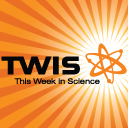Podcast: Play in new window | Download (Duration: 1:53:18 — 104.2MB)
What is in the This Week in Science Podcast?
Spending Cuts For Science, Mammoth Mouse, Art Rocks, Transient Anatomy, Horseshoe Spiders, Festival Henge, Dusty Space, Pain Pits?, Controlling Birth Control, Allergy Meds, Physics Combs, Work Gratitude, And Much More…
Want to listen to a particular story from TWIS, the This Week in Science podcast? You can do that here. Just look for the time-code link in the description.
DISCLAIMER, DISCLAIMER, DISCLAIMER!!!
People have opinions about everything.
And while deep learning algorithms set to work on determining how often those opinions turn out to represent reality throughout history are either still running with no end in sight…
Or, have crashed due to human programming errors…
Preliminary data suggests that in general…
humans are no more accurate at forming opinions that represent reality at age 8 than they are at age 80…
And, even this was far below the threshold of coin flipping between the actual answer and utter nonsense.
(seven year old opinions were excluded from the study because of their uncanny ability to recognize nonsense…
and, by elimination, choose the correct answer every time.)
The following program is designed to assist in disregarding human opinions about how the world works.
By listening carefully you will accumulate the knowledge required to deflect erroneous opinions in favor of super awesome facts…
If you listen carelessly you might get some things wrong, but you’ll still be well ahead of the average human.
We offer this service free of charge because we too understand what it’s like to be curious about reality in a sea of self-deluding human opinions…
And in our sometimes less than humble opinion,
there is no better way to stay above the opinionated fray than…
This Week in Science,
Coming Up Next…
What Are This Week’s Top Stories?
Spending Cuts For Science
The Trump administration’s proposed budget for 2020 is full of massive cuts for federally funded science.
Mammoth Mouse
Researchers were able to get nuclei from 24,000 year old mammoth cells to partially activate when put inside mouse oocytes.
Ancient art reveals origin of “stork” theory on where babies come from…
… or, it’s suggestive of early communication efforts by humans.
Blair’s Animal Corner!… with Blair!
Ah, the transient anus
Ctenophores answer the age old question, why poop? And from where? And how??
Horseshoe crabs are not crabs
They are indeed, arachnids!
Support us on Patreon!
This Week in What Has Science Done for me Lately?!?
“Hi Kiki,
My “WHSDFML” is more What Has Science Done for a Stranger Lately.
I have been on the non-profit bone marrow donor registry from BeTheMatch.org for 9 years. Last month, I donated peripheral blood stem cells for a person who I matched with, a patient with ALL (acute lymphoblastic leukemia). This is often the last resort for someone battling this disease. It was a simple process with (for me) zero side effects other than the wonderful feeling that SCIENCE has discovered a simple and effective method that let me give a stranger another shot at life.
The standard method of blood stem cell donation used to be bone marrow aspiration, where the cells are obtained by drilling into a bone and sucking out marrow. Needless to say, this life-saving process is painful, invasive, and requires significant recovery. SCIENTISTS developed a drug to help stimulate blood stem cells in cancer patients receiving chemotherapy, and realized it was also a good way to stimulate bone stem cell production in donor patients.
After 5 days of injections with this medication, my white blood cell count was high enough to have the blood stem cells harvested through aphoresis, similar to platelet collection. A small amount of blood was removed, the desired cells harvested, and the remainder blood was put back. After a few hours enough cells were harvested to be able to repopulate the recipient’s entire blood system. I felt totally normal two days later, after essentially providing a life-saving organ transplant.
I encourage all TWIS listeners to sign up to be on the registry. Donor blood stem cells are used to treat many different, mostly life-threatening diseases. It is quite rare to match with a patient, so I feel particularly lucky to have been able to do this for another person. Check out BeTheMatch.org to learn how to get on the registry.
Thank you to the three of you for bringing amazing science to the spotlight every week.
Kindest regards, Ashleigh”
And, NOW, Some Science News From This Week in Science
Stonehenge Mystery SOLVED!
again…
Dusty Space
Turns out there are dust rings around the sun that follow the paths of the inner planets. Perhaps they will tell us about our solar system.
Anti-inflammatory Avocado Pits
Don’t eat avocado pits, but maybe look forward to medicines based on their anti-inflammatory powers.
Birth control Not Working?
Some women have a gene that helps hormone breakdown, and could explain why birth control doesn’t work for everyone.
Allergic To Meds?
The extra stuff in medication could be causing you trouble.
And, finally, Some Quick Science News Stories To End The Show
The scientific way to comb hair Start at the end of course!
Thanks physics?
Be Grateful…
At work!


